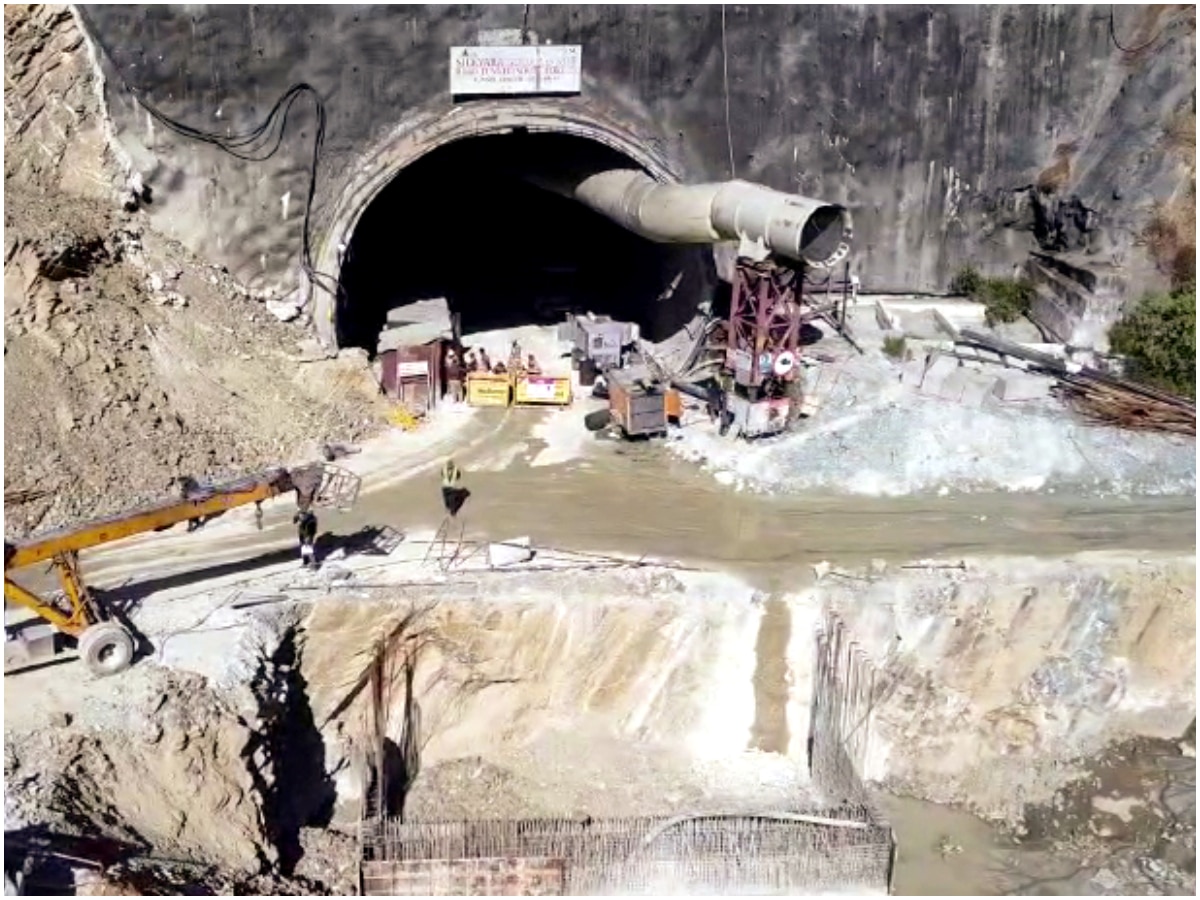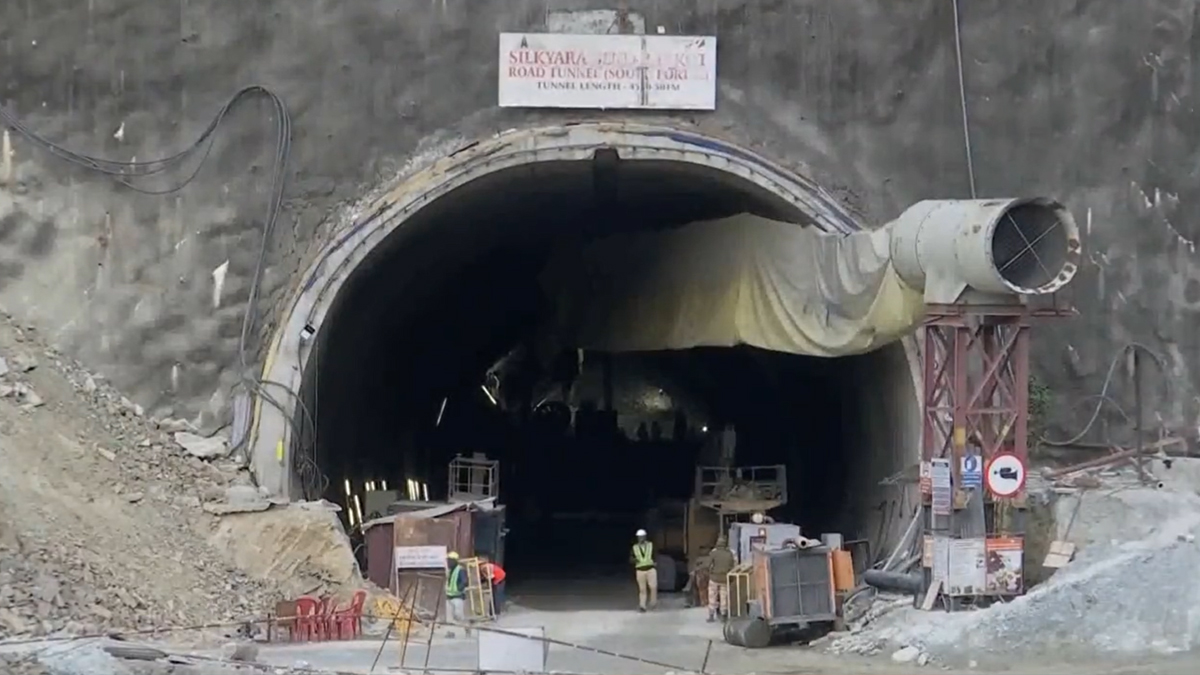Uttarkashi Tunnel Collapse Live Update: Another drilling machine airlifted from Indore as rescue operation halts

Uttarkashi Tunnel Collapse Live Update: Another drilling machine airlifted from Indore as rescue operation halts
In the Uttarkashi district of Uttarakhand, India, a dire situation has unfolded as at least 10 workers find themselves trapped inside the Silkyara tunnel, which partially collapsed on November 12. The incident has prompted urgent rescue efforts amid challenging conditions. The tunnel, part of a hydroelectric project, experienced the collapse, leaving workers stranded and prompting a large-scale response to free those trapped.
The rescue operations have faced setbacks, including technical challenges with a US-made auger machine, deployed for drilling and pushing in pipes to facilitate the rescue. Unfortunately, this critical piece of equipment developed a snag, causing a halt in the ongoing rescue efforts. The complexity of the rescue mission is compounded by the rugged terrain and adverse weather conditions in the region.
The Silkyara tunnel collapse has triggered concerns about the safety and preparedness measures in place for infrastructure projects, especially those involving tunnels and remote locations. The incident underscores the importance of stringent safety protocols and effective emergency response mechanisms in such projects.
The trapped workers’ well-being and the successful execution of the rescue operation remain top priorities for the authorities involved. The incident has also led to reflections on the broader aspects of infrastructure development, safety regulations, and the need for robust contingency plans to address unforeseen challenges.
The use of advanced equipment, such as the auger machine, highlights the technological aspects involved in modern infrastructure projects. However, as witnessed in this incident, technical issues can arise, emphasizing the need for contingency plans and backup strategies to ensure the safety of workers and the success of rescue operations.
As the situation unfolds, attention will likely be focused on the collaborative efforts of rescue teams, the timely resolution of technical glitches, and the implementation of comprehensive safety measures to prevent similar incidents in the future. The incident serves as a somber reminder of the inherent risks associated with large-scale infrastructure projects and the paramount importance of prioritizing safety and emergency preparedness.
On Friday, around 2:45 pm, a critical incident unfolded during the rescue operation in the Silkyara tunnel in Uttarkashi, Uttarakhand. While positioning the fifth pipe, a loud cracking sound reverberated within the tunnel, prompting an immediate suspension of the rescue operation. The National Highways and Infrastructure Development Corporation (NHIDCL) issued a statement late on Friday night, detailing the events leading to the temporary halt in the rescue efforts.
The audible cracking sound raised concerns about the stability and safety of the tunnel, prompting a cautious approach to ensure the well-being of the trapped workers and the safety of the rescue teams. The incident underscores the technical challenges and uncertainties involved in such complex rescue operations, particularly in rugged terrains and adverse conditions.
The decision to suspend the rescue operation reflects the prioritization of safety and the need for a thorough assessment of the situation before proceeding further. The statement from NHIDCL provides a glimpse into the intricacies of the ongoing efforts and the considerations involved in managing unforeseen developments during the rescue mission.
As the situation evolves, authorities and rescue teams are likely to conduct a comprehensive analysis of the tunnel’s stability, considering the cracking sound as a potential indicator of structural issues. The incident highlights the critical nature of rescue operations and the importance of meticulous planning, technical expertise, and a commitment to the safety of all personnel involved.
The temporary suspension underscores the challenges associated with rescue efforts in dynamic and unpredictable environments, emphasizing the need for a measured and cautious approach to ensure the success of the operation and the well-being of those involved.
The Silkyara Tunnel, spanning a length of 4531 meters, holds significance as a crucial component of the Chardham Project led by the Ministry of Road Transport and Highways. This ambitious project aims to link the Gangotri and Yamunotri axis through the construction of the Silkyara Tunnel, strategically positioned under the Radi pass area.
The Chardham Project is a vital infrastructure initiative designed to improve connectivity to the sacred shrines of Gangotri, Yamunotri, Kedarnath, and Badrinath, which collectively form the Chardham circuit in the Himalayan region. Enhancing road connectivity to these revered pilgrimage sites holds cultural, religious, and socio-economic importance, allowing pilgrims and tourists easier access to these destinations.
The Silkyara Tunnel, being a key element of this project, facilitates smoother and more efficient travel between Gangotri and Yamunotri, contributing to the overall development of the region and improving accessibility for pilgrims and tourists alike. However, the recent incident of tunnel collapse has brought attention to the challenges and risks associated with the construction of such complex infrastructure projects in challenging terrains.
The success of the Chardham Project, including the safe completion of the Silkyara Tunnel, remains a priority, and the recent developments necessitate a thorough evaluation of safety protocols and technical aspects to ensure the well-being of the workers and the structural integrity of the tunnel. The incident serves as a reminder of the complexities inherent in large-scale infrastructure projects, particularly in geographically demanding regions, and emphasizes the need for stringent safety measures and robust emergency response mechanisms.
The anguish and uncertainty continue to mount as the ordeal persists for the families of the 41 laborers trapped inside the collapsed Silkyara tunnel on the Char Dham route. The under-construction tunnel, a crucial component of the Char Dham Project, suffered a collapse on Sunday morning, entombing the workers and triggering a prolonged and challenging rescue operation.
As the days pass, the voices of those awaiting news about their trapped relatives are becoming increasingly strained. The atmosphere outside the tunnel is fraught with anxiety as families keep vigil, hoping for positive developments in the ongoing rescue efforts. The situation has evolved into a protracted ordeal, stretching into the seventh day, amplifying concerns about the well-being and endurance of those trapped inside.
The collapse of the tunnel has brought to the forefront the complexities and risks associated with large-scale infrastructure projects, especially in challenging terrains. The Char Dham Project, aimed at improving connectivity to sacred shrines in the Himalayan region, has faced an unexpected and tragic turn with the tunnel collapse, leading to a heightened focus on safety measures and emergency response protocols.
The rescue operation, marked by technical challenges and unpredictable conditions, reflects the dedication and determination of the rescue teams working tirelessly to reach the trapped laborers. The situation, however, remains precarious, with the families outside the tunnel grappling with the emotional toll of the prolonged wait and the uncertainty surrounding the fate of their loved ones.
The incident underscores the need for meticulous planning, stringent safety measures, and efficient emergency response mechanisms in large-scale infrastructure projects, especially those in geographically demanding regions. The coming days will be critical as rescue efforts continue, and the nation holds its breath in collective hope for a successful and swift resolution to this challenging crisis.
The National Green Tribunal (NGT) has initiated action by issuing notices to relevant authorities, including the National Highways and Infrastructure Development Corporation Ltd (NHIDCL), based on a petition highlighting the absence of certain protective measures on the Gangotri National Highway in Uttarkashi district, Uttarakhand.
The petition contends that the NHIDCL has not taken appropriate measures for the construction of critical protective infrastructure, including a landslide protection gallery, slope protection work, and river protection work. These protective measures are essential for ensuring the stability and safety of the Gangotri National Highway, which is of strategic importance in the region.
The NGT’s issuance of notices signals a response to concerns raised about the lack of necessary protective works along the highway, particularly in areas prone to natural hazards such as landslides and river erosion. The petition underscores the importance of addressing environmental and safety considerations in the development and maintenance of critical infrastructure projects.
As the case progresses, authorities are likely to be called upon to provide explanations and take corrective actions to address the identified shortcomings in protective measures along the Gangotri National Highway. The NGT’s involvement underscores its role in overseeing environmental matters and ensuring compliance with established norms and regulations to safeguard both infrastructure integrity and environmental sustainability.




